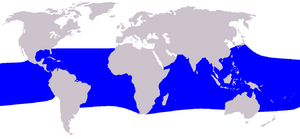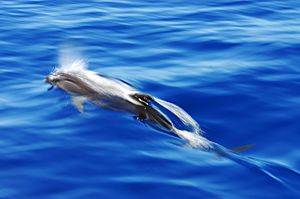Fraser's dolphin facts for kids
Quick facts for kids Fraser's dolphin |
|
|---|---|
 |
|
 |
|
| Size compared to an average human | |
| Conservation status | |
| Scientific classification | |
| Genus: |
Lagenodelphis
|
| Species: |
hosei
|
 |
|
| Fraser's dolphin range | |
The Fraser's dolphin (scientific name: Lagenodelphis hosei), also known as the Sarawak dolphin, is a type of oceanic dolphin. These dolphins live in the deep parts of the Pacific Ocean, and you can also find them in smaller numbers in the Indian Ocean and Atlantic Ocean.
Contents
What Does a Fraser's Dolphin Look Like?
When a Fraser's dolphin is born, it is about 1 meter (3.3 feet) long and weighs around 20 kilograms (44 pounds). As they grow up, they can reach about 2.75 meters (9 feet) long and weigh up to 200 kilograms (440 pounds).
These dolphins have a strong, solid body shape. They have a small dorsal fin (the fin on their back) and tiny flippers compared to their body size. Their snout, or "beak," is also quite small.
Their upper body is usually gray-blue or gray-brown. A creamy white line runs along their sides, starting from their snout, going above their eye, and ending near their tail. Below this line, there is a darker stripe. Their belly and throat are typically white, sometimes with a pinkish tint.
One special thing about the Fraser's dolphin is its small, not-so-obvious beak. From far away, people might confuse them with striped dolphins because they have similar colors and live in the same areas.
How Do Fraser's Dolphins Behave?
Fraser's dolphins are very fast swimmers. They often travel in huge, tightly packed groups, sometimes with 100 to 1000 dolphins! When they swim quickly, they often "porpoise," which means they leap out of the water. Seeing a large group of these dolphins speeding away from a boat can be a very exciting sight.
These dolphins eat pelagic fish (fish that live in open water), squid, and shrimp. They find their food deep underwater, usually between 200 to 500 meters (650 to 1,640 feet) below the surface. At these depths, there is almost no sunlight. So, Fraser's dolphins use echolocation (like sonar) to find their prey in the dark.
Where Do Fraser's Dolphins Live?

Even though scientists only learned about Fraser's dolphins fairly recently, many more sightings have been reported lately. This suggests that they might not be as rare as people thought in the 1980s. However, we still don't know as much about them as we do about dolphins that live closer to shore. There isn't a total count of how many Fraser's dolphins there are in the world.
These dolphins are usually seen in deep, warm waters, mainly between 30° South and 20° North of the equator. The eastern part of the Pacific Ocean is one of the best places to spot them.
Sometimes, groups of Fraser's dolphins have been found stranded on beaches in places like France and Uruguay. These events are unusual and might happen because of strange ocean conditions, like El Niño. El Niño is a natural climate pattern that changes ocean temperatures and currents.
Fraser's dolphins are also quite common in the Gulf of Mexico. However, you see them less often in other parts of the Atlantic Ocean. The Philippines is especially known for dolphin sightings and has one of the largest populations of Fraser's dolphins in the world.
See also
 In Spanish: Delfín de Fraser o de Sarawak para niños
In Spanish: Delfín de Fraser o de Sarawak para niños


